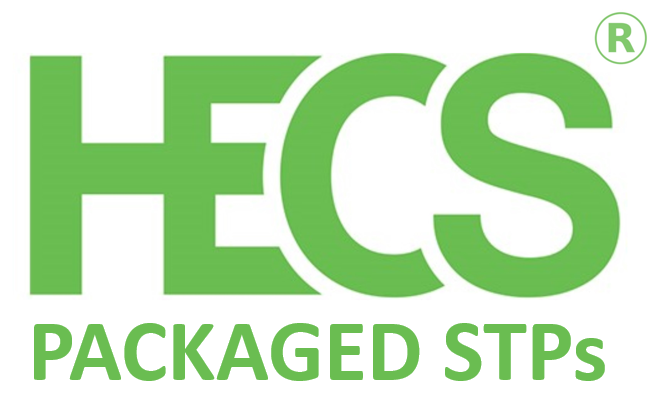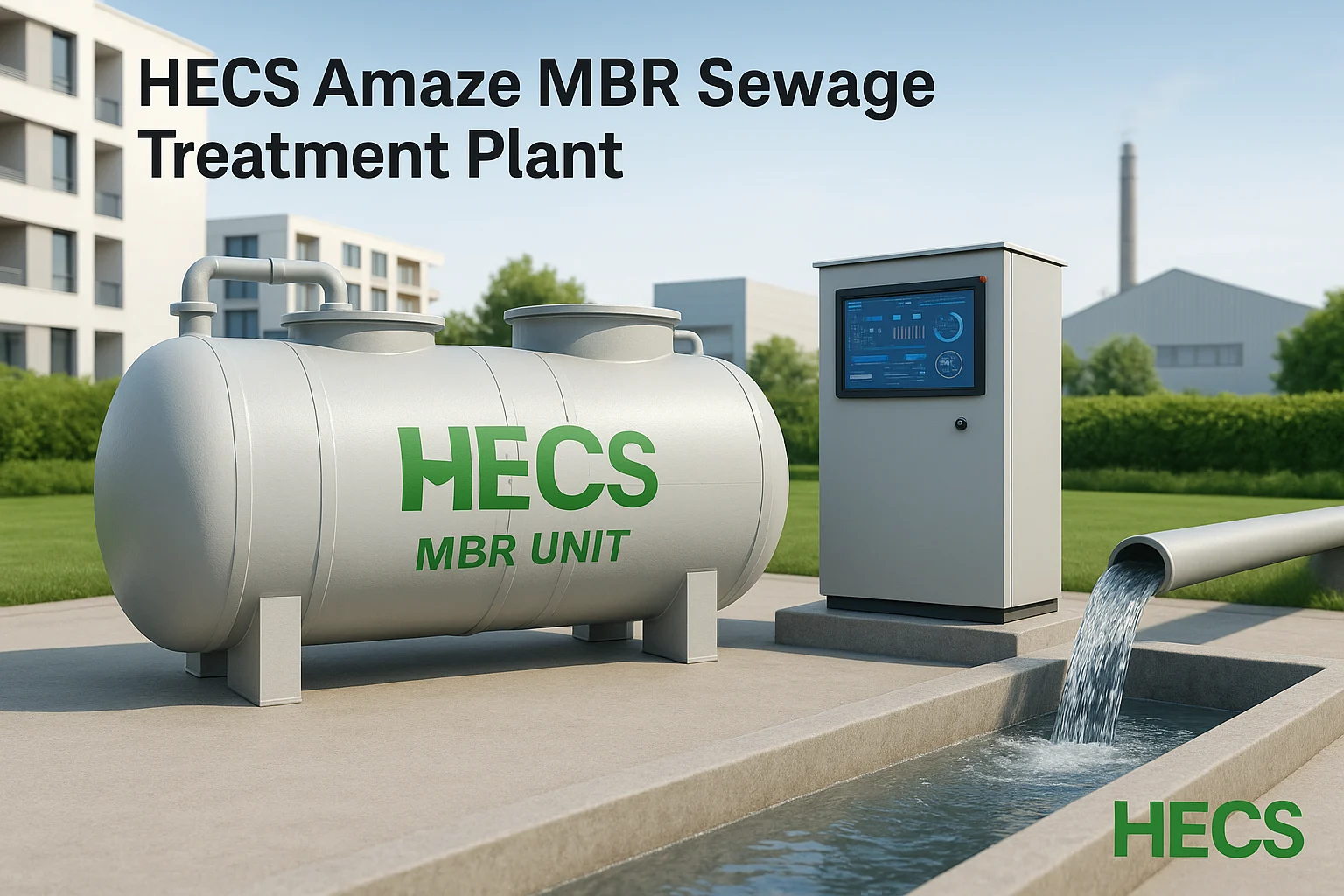Why HECS Amaze MBR Technology is Revolutionising Sewage Treatment Plants Worldwide
Water scarcity affects over 2 billion people globally, making efficient wastewater treatment more critical than ever. Industries and municipalities face increasingly stringent environmental regulations while seeking cost-effective solutions. The HECS Amaze MBR Sewage Treatment Plant emerges as the leading solution for sustainable wastewater management.
What is MBR Technology and How Does HECS Amaze Lead the Market?
Membrane Bioreactor (MBR) technology combines biological treatment with advanced membrane filtration. The HECS Amaze MBR Sewage Treatment Plant represents the next generation of this proven technology, delivering superior performance for residential, commercial, and industrial applications.
Unlike conventional sewage treatment plants, HECS Amaze MBR systems produce high-quality treated water suitable for immediate reuse, addressing both water scarcity and environmental compliance challenges.
Top 8 Benefits of HECS Amaze MBR Sewage Treatment Plant
1. Exceptional Treatment Efficiency
- 99% removal efficiency for pathogens, organic matter, and suspended solids
- Consistently meets and exceeds international discharge standards
- Produces clear effluent perfect for reuse applications
2. Space-Saving Modular Design
- Compact footprint reduces land requirements by up to 70%
- Plug-and-play installation minimizes construction time
- Perfect for urban environments with limited space
3. Smart IoT/AI Monitoring System
- 24/7 real-time monitoring through advanced SmartHub technology
- Predictive maintenance reduces operational downtime
- Automated alerts prevent system failures before they occur
4. Minimal Sludge Production
- Ultra-low sludge generation reduces disposal costs significantly
- Advanced biological processes minimize environmental impact
- Lower waste management expenses improve ROI
5. Energy-Efficient Operations
- Optimized aeration systems reduce power consumption by 30-40%
- Smart controls adjust operations based on real-time demand
- Lower operational costs compared to conventional treatment methods
6. Rapid Deployment
- Pre-engineered modules enable quick installation
- Minimal site disruption during construction
- Faster project completion timelines
7. Versatile Applications
- Residential complexes and townships
Commercial buildings and offices - Industrial facilities and manufacturing plants
- Hotels, hospitals, and educational institutions
8. Long-Term Reliability
- Robust membrane technology ensures consistent performance
- Low maintenance requirements reduce operational burden
- Extended equipment lifespan maximizes investment value
How HECS Amaze MBR Sewage Treatment Process Works: Step-by-Step Guide
Stage 1: Primary Screening and Grit Removal
- Raw sewage enters the HECS Amaze MBR system where mechanical screening removes coarse materials, debris, and grit particles. This critical preprocessing step protects downstream equipment and optimizes overall treatment efficiency.
Stage 2: Advanced Biological Treatment
- The system’s sophisticated aeration chamber houses specially cultivated microorganisms that break down organic pollutants. Controlled oxygen levels ensure optimal biological activity while maintaining energy efficiency.
Stage 3: Membrane Filtration Technology
- Ultra-fine membrane modules integrated within the biological reactor simultaneously filter treated water. This innovative design eliminates the need for separate clarification tanks, reducing system footprint while improving treatment quality.
Stage 4: Intelligent Sludge Management
- The system recirculates active biomass back to the biological reactor, maintaining optimal microbial populations. This intelligent sludge recirculation minimizes waste generation while maximizing treatment efficiency.
Stage 5: High-Quality Effluent Production
The final treated water meets stringent quality standards, making it suitable for:
- Irrigation systems for landscaping and agriculture
- Toilet flushing in commercial and residential buildings
- Cooling tower makeup water for HVAC systems
- Industrial process water for manufacturing applications
HECS Amaze vs. Conventional Sewage Treatment: Why MBR Technology Wins
Feature | HECS Amaze MBR | Conventional Treatment |
Treatment Quality | 99% efficiency | 85-90% efficiency |
Space Requirement | 70% less footprint | Large land area needed |
Sludge Production | Ultra-low | High volumes |
Energy Consumption | 30-40% lower | Standard consumption |
Maintenance | Minimal | Regular intensive maintenance |
Water Reuse | Immediate reuse quality | Requires additional treatment |
Industries Benefiting from HECS Amaze MBR Sewage Treatment Plants
Residential Developments
- Gated communities require sustainable water management
- Apartment complexes with limited space for treatment facilities
- Township projects seeking long-term operational efficiency
Commercial Establishments
- Shopping malls and retail centres
- Office complexes and business parks
- Hotels and hospitality facilities prioritise guest satisfaction
Industrial Applications
- Manufacturing facilities with strict discharge requirements
- Food processing plants require high-quality process water
- Pharmaceutical companies meeting regulatory compliance standards
Why HECS Amaze MBR Delivers Superior ROI
- Initial Investment Advantages
- Lower civil construction costs due to compact design
- Reduced land acquisition requirements
- Faster installation minimises project delays
Operational Cost Savings
- 30-50% lower energy consumption compared to conventional systems
- Minimal sludge disposal costs
- Reduced chemical requirements for treatment processes
- Lower maintenance expenses due to automated operations
Revenue Generation Opportunities
- Water reuse reduces freshwater purchase costs
- Compliance benefits avoid regulatory penalties
- Property value enhancement through sustainable infrastructure.
Environmental Impact and Sustainability Benefits
The HECS Amaze MBR Sewage Treatment Plant contributes to environmental conservation through:
- Water conservation by enabling the immediate reuse of treated wastewater
- Reduced carbon footprint through energy-efficient operations
- Minimal chemical usage protects local ecosystems
- Zero-discharge capabilities prevent groundwater contamination
Installation and Maintenance: What to Expect
Quick Installation Process
- Site preparation and foundation work
- Module placement and connection
- System commissioning and testing
- Training and handover
Minimal Maintenance Requirements
- Monthly visual inspections of system components
- Quarterly membrane cleaning using automated procedures
- Annual comprehensive system audit and optimisation
- 24/7 remote monitoring through SmartHub technology
Conclusion: Transform Your Wastewater Management with HECS Amaze MBR
The HECS Amaze MBR Sewage Treatment Plant represents the future of sustainable wastewater management. By combining advanced membrane technology with intelligent automation, it delivers superior treatment quality while minimising operational costs and environmental impact.
Whether you’re developing a residential project, managing a commercial facility, or operating an industrial plant, the HECS Amaze MBR system provides a proven pathway to water independence and regulatory compliance.
Ready to revolutionise your wastewater treatment approach? Contact our technical experts today for a comprehensive site assessment and personalised consultation. Discover how the HECS Amaze MBR Sewage Treatment Plant can transform your wastewater challenges into sustainable opportunities.
Let's Talk Sustainability – Contact HECS Today!
Looking for reliable wastewater treatment solutions? Get expert guidance and find the perfect STP for your needs today!
Frequently Asked Questions
1. What is the HECS Amaze MBR Sewage Treatment Plant, and how does it work?
The HECS Amaze MBR Sewage Treatment Plant is an advanced membrane bioreactor system that combines biological treatment with ultrafiltration membrane technology for superior wastewater treatment. The system uses an activated sludge process followed by membrane filtration to remove contaminants, bacteria, and suspended solids from sewage. This dual-stage treatment produces high-quality effluent suitable for reuse in irrigation, toilet flushing, and industrial applications.
2. How much does the HECS Amaze MBR Sewage Treatment Plant cost in India?
HECS Amaze MBR Sewage Treatment Plant costs typically range from ₹8-15 lakhs for residential systems (10-50 KLD capacity) and ₹25-80 lakhs for commercial installations (100-500 KLD capacity). The total investment includes equipment, installation, civil work, and commissioning, with operating costs of ₹2-4 per KL of treated water. Government subsidies and financing options are available for eco-friendly sewage treatment installations.
3. What is the installation process for HECS Amaze MBR Sewage Treatment Plant?
HECS Amaze MBR Sewage Treatment Plant installation involves site preparation, civil construction of treatment tanks, mechanical equipment setup, and electrical connections within 15-30 days. The process includes excavation, concrete work, membrane module installation, blower setup, and control panel commissioning by certified technicians. Pre-installation site survey and soil testing are mandatory for optimal system performance and compliance with local regulations.
4. Can treated water from HECS Amaze MBR Sewage Treatment Plant be reused safely?
HECS Amaze MBR Sewage Treatment Plant produces treated water that meets IS 13592 and WHO standards for non-potable reuse applications like gardening, toilet flushing, and cooling towers. The advanced membrane filtration removes 99.9% of bacteria, viruses, and suspended solids, making it safe for irrigation and industrial processes. Regular water quality testing ensures consistent compliance with environmental and health safety standards.
5. What maintenance is required for the HECS Amaze MBR Sewage Treatment Plant?
HECS Amaze MBR Sewage Treatment Plant requires monthly membrane cleaning, quarterly sludge removal, and annual comprehensive servicing to maintain optimal performance. Daily operational checks include monitoring flow rates, pressure levels, and electrical systems, while membrane replacement is needed every 3-5 years. Professional maintenance contracts are available starting from ₹15,000 annually, covering all routine services and emergency support.
6. What are the main benefits of HECS Amaze MBR Sewage Treatment Plant over conventional systems?
HECS Amaze MBR Sewage Treatment Plant offers superior effluent quality (BOD <10 mg/L), 60% smaller footprint, and 90% less sludge production compared to conventional activated sludge systems. The membrane technology eliminates secondary clarifiers, reduces land requirements, and provides consistent treatment regardless of influent variations. Higher capital investment is offset by lower operating costs, water reuse benefits, and reduced environmental compliance risks.
7. What capacity options are available for MBR Sewage Treatment Plant?
MBR Sewage Treatment Plant is available in modular capacities ranging from 5 KLD for small residences to 5000 KLD for large commercial and industrial applications. Standard residential models include 10, 25, and 50 KLD systems, while commercial options range from 100-1000 KLD with expandable configurations. Custom capacities can be designed based on specific flow requirements and future expansion needs.
8. How does HECS Amaze MBR Sewage Treatment Plant compare to SBR and MBBR systems?
HECS Amaze MBR Sewage Treatment Plant provides superior effluent quality and a smaller footprint compared to SBR (Sequencing Batch Reactor) and MBBR (Moving Bed Biofilm Reactor) systems. While SBR and MBBR systems cost 30-40% less initially, MBR technology offers better pathogen removal, consistent performance, and direct reuse capability without tertiary treatment. MBR systems require higher energy consumption but eliminate the need for additional filtration stages.
9. What are the power consumption and operating costs of HECS Amaze MBR Sewage Treatment Plant?
HECS Amaze MBR Sewage Treatment Plant consumes 3-5 kWh per cubic meter of treated water, with monthly electricity costs ranging from ₹8,000-25,000 for typical residential to commercial installations. Total operating expenses include power, chemicals, maintenance, and membrane replacement, averaging ₹2-4 per KL of treated water. Energy-efficient blowers and automated controls help minimize power consumption while maintaining optimal treatment performance.
10. Does HECS Amaze MBR Sewage Treatment Plant require pollution control board approval?
HECS Amaze MBR Sewage Treatment Plant installations above 100 KLD capacity require State Pollution Control Board (SPCB) consent to establish and consent to operate approvals. The approval process involves submitting detailed project reports, environmental impact assessments, and compliance monitoring plans within 60-90 days. Smaller residential systems may require local municipal permissions, and all installations must meet IS 13592 discharge standards for legal operation.

